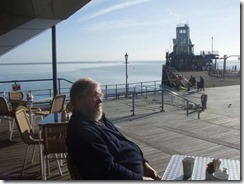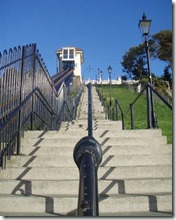David and I have very different memories of our visit to Southend Pier (above) in late October. He thoroughly enjoyed the wide open space at the Pier Head where it was so easy to walk around and take in the views of the Thames estuary.
At 1.34 miles (2.16km) in length it is the longest pleasure pier in the world and there is a small railway running along most of it. “I love the little train and they’ve made a good job of the end of the pier. It was convenient, comfortable and pleasant. It was great – I loved it. And the weather was great,” David said.
We were certainly fortunate because after a week of bad weather our short visit to Southend was bathed in sunshine. It was almost too hot as we sat outside the Pier Café on the south side of the new Royal Pavilion. (Left: outside the café with the RNLI station in the background)
There was a warm welcome at the café and at the RNLI lifeboat station gift shop. The station was interesting as two of the lifeboats based at Southend can be viewed there and there is a small pictorial archive of information about it. The other two lifeboats, including a small hovercraft, are housed at the shore-end of the pier.
But for me there was a deep sense of loss. Where had the old pub, cafés and amusements gone which had been so much part of the East End of London working class culture? Who had “gentrified” the pier?
No-one can really be blamed for that because their loss was due to the fires which have ravaged the pier the final one being in October 2005. The heat was so intense during that fire that it buckled the railway track – and so the trains now stop 15m short of the old station. (below left: the pier train at the new station)
Back on shore we were sad that we were too late in the season for a ride on the counter-balanced funicular railway (above right) but decided not to experience the modern lift into the shopping mall.
Instead David opted to visit the Sea Life Adventure centre. “It was fascinating to see tropical fish in their own environment but some of the bigger fish were obviously uncomfortable, swimming around the edges as they do,” David commented.
On that trip to Essex we also visited the “secret” nuclear bunker at Kelvedon Hatch near Brentwood. This underground labyrinth with its 10ft thick reinforced concrete shell and massive 1.5 tonne blast doors provided an intriguing insight into the mentality of the cold war. There are three levels: the ground floor for communications and also the plant room from where recycled breathable air would have been circulated ; the second as a regional or government headquarters; and at the top the dormitories, a small surgery, washrooms and a large canteen.
David said: “The bunker was fascinating – all that money and effort spent on preparing for something that never happened fortunately. But there is one of those in every county and one virtually for every council of some sort of another you realise they spent a lot of money on these during the cold war period.”
And what most impressed him inside that bunker? “The noise levels, the lack of sound control which a group of school kids highlighted. It just echoed round all through it so it would have been hell to work in, particularly when it was full of the numbers of people that it was envisaged working in there. It would have been uncomfortable. It was quite well planned out but whether it would have worked or not I don’t know.”
On view in the bunker were old black and white television documentaries which reminded us of government warnings on how to prepare for a nuclear attack. But then how many could have afforded to have built nuclear shelters inside their homes or stocked up with so much food and water? Instead we just got on with life and hoped for the best!
Below – Jet streams over Southend




